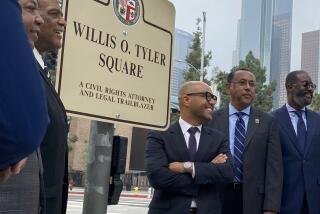CHANGE AT THE COURT
- Share via
Here are some of the highlights of Thurgood Marshall’s career as a civil rights lawyer and his 24 years as a liberal on the Supreme Court. CAREER HIGHLIGHTS
* As a lawyer for the NAACP Legal Defense and Education Fund from 1940 to 1961, helped formulate and press the group’s strategy of using federal law to gain minority rights in voting, housing, public accommodations and education.
* In 1954, as legal defense and educational fund attorney, headed the team that argued Brown v. Board of Education before the U.S. Supreme Court. The case led to court ruling that declared school segregation unconstitutional.
* In 1957, represented nine black Little Rock, Ark., students who tried to integrate Central High School, challenging segregationist Gov. Orval Faubus.
* Named U.S. Court of Appeals Judge by President Kennedy in 1961.
* Named U.S. Solicitor General by President Lyndon Johnson in 1965. As the government’s chief advocate before the U.S. Supreme Court, won the court’s approval of the Voting Rights Act of 1965, and joined in a suit that successfully overturned a California constitutional amendment that prhobited open housing legislation.
* Named the first black justice of the U.S. Supreme Court by President Johnson in June, 1967. Confirnmed by the Senate by a vote of 69 to 11.
* In 1969, wrote the majority opinion in Stanley v. Georgia , a landmark personal privacy case, in which the court found states cannot ban the mere possession of obscene material.
* In 1987, wrote the majority opinion in California Federal v. Guerra , in which the court said the federal law prohibing employers from discriminating against pregnant women doesn’t bar firms from discriminating in their favor.
“The position of the Negro today in America is the tragic but inevitable consequence of centuries of unequal treatment. Measured by any benchmark of comfort or achievement, meaningful equality remains a distant dream for the Negro.”
More to Read
Sign up for Essential California
The most important California stories and recommendations in your inbox every morning.
You may occasionally receive promotional content from the Los Angeles Times.













